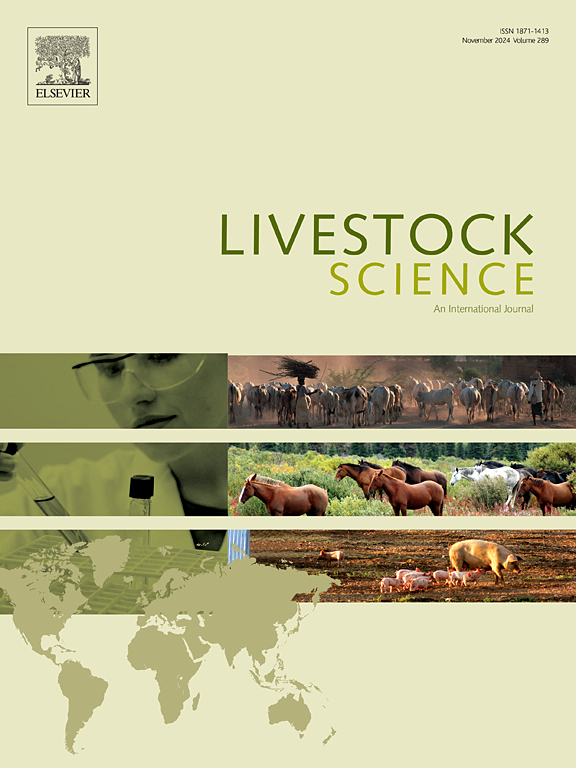Impact of a ten-week lactation period on sow and litter performance in organic outdoor production
IF 1.8
3区 农林科学
Q2 AGRICULTURE, DAIRY & ANIMAL SCIENCE
引用次数: 0
Abstract
In recent years the average lactation period for organic pigs reared outdoors has been extended to improve piglet robustness at weaning and to eliminate the need for a separate weaner facility. This study aimed to investigate the performance of outdoor sows and litters after lactation periods of seven and 10 weeks. Twenty litters comprising a total of 251 pigs were assigned to one of two weaning strategies: weaning at seven weeks or weaning at 10 weeks. Post-weaning, the piglets were transferred to outdoor weaner paddocks and monitored until they reached 17 weeks of age. Sows' body weight (BW), back fat thickness (BF), udder, and teat condition were assessed after seven and 10 weeks of lactation. Piglets were weighed at the end of week 7, 10, 14, and 17 post-partum. Sow feed intake was recorded from weeks 8 to 10, while piglets' feed intake was monitored from weeks 8 to 10, 11 to 14, and 15 to 17. There were no changes in sow BF, teat, and udder condition during the three-week extended lactation period (P > 0.05). Sows exhibited an increase in BW by 8.8 kg during the three-week extended lactation period (P < 0.01). The weaning strategy did not affect piglets' average daily gain (ADG), feed intake (ADFI), or feed conversion ratio (FCR), in terms of kg feed per kg gain, from week 10 to 14, as well as ADG and ADFI from week 15 to 17 (P > 0.05). Overall, pigs per litter after 17 weeks and total gain (sow and pigs) from week 8 to 17 did not differ between weaning strategies (P > 0.05). When including feed use for sows, piglets, and weaners, overall FCR in terms of kg feed per kg gain was numerically higher for litters weaned after 10 weeks of lactation (P = 0.11). However, overall FCR in terms of kg crude protein (CP) and metabolizable energy (ME) per kg gain did not differ between weaning strategies (P > 0.05). In conclusion, extended lactation had no detrimental effects on outdoor sows’ body condition and udder condition at weaning. On the other hand, when the piglets are weaned in outdoor conditions, in small group sizes and sorted according to size, weaning at seven or 10 weeks of age seems to be equally suitable strategies to obtain good pig health and high growth rates until 17 weeks of age.
有机户外生产中10周哺乳期对母猪和产仔生产性能的影响
近年来,户外有机猪的平均泌乳期已经延长,以提高仔猪断奶时的健壮性,并消除了对单独断奶设施的需要。本试验旨在研究哺乳7周和10周后户外母猪和窝仔的生产性能。20窝共251头猪被分配到两种断奶策略中的一种:7周断奶或10周断奶。断奶后,仔猪被转移到室外断奶围场并进行监测,直到它们达到17周龄。在哺乳7周和10周后,分别对母猪的体重(BW)、背膘厚(BF)、乳房和乳头状况进行评估。分别于产后第7、10、14和17周末称重。在第8 ~ 10周记录母猪采食量,在第8 ~ 10周、第11 ~ 14周和第15 ~ 17周监测仔猪采食量。在延长的3周哺乳期,母猪BF、泌乳和乳腺状况均无变化(P >;0.05)。母猪在延长的3周哺乳期体重增加了8.8 kg (P <;0.01)。断奶策略不影响仔猪第10 ~ 14周的平均日增重(ADG)、采食量(ADFI)和饲料系数(FCR)(以每公斤增重公斤饲料计),也不影响第15 ~ 17周的ADG和ADFI (P >;0.05)。总体而言,断奶后17周每窝生猪数和第8至17周的总增重(母猪和猪)在断奶策略之间没有差异(P >;0.05)。当包括母猪、仔猪和断奶仔猪的饲料用量时,以每公斤增重公斤饲料计算的总饲料转化率在哺乳10周后断奶的窝中数值更高(P = 0.11)。然而,断奶策略之间,每公斤增重kg粗蛋白质(CP)和代谢能(ME)的总FCR没有差异(P >;0.05)。由此可见,延长哺乳时间对室外母猪断奶时的体况和乳腺状况无不利影响。另一方面,当仔猪在室外条件下断奶时,根据大小进行分组,7周龄或10周龄断奶似乎是同样合适的策略,以获得良好的猪健康和高生长速度,直到17周龄。
本文章由计算机程序翻译,如有差异,请以英文原文为准。
求助全文
约1分钟内获得全文
求助全文
来源期刊

Livestock Science
农林科学-奶制品与动物科学
CiteScore
4.30
自引率
5.60%
发文量
237
审稿时长
3 months
期刊介绍:
Livestock Science promotes the sound development of the livestock sector by publishing original, peer-reviewed research and review articles covering all aspects of this broad field. The journal welcomes submissions on the avant-garde areas of animal genetics, breeding, growth, reproduction, nutrition, physiology, and behaviour in addition to genetic resources, welfare, ethics, health, management and production systems. The high-quality content of this journal reflects the truly international nature of this broad area of research.
 求助内容:
求助内容: 应助结果提醒方式:
应助结果提醒方式:


